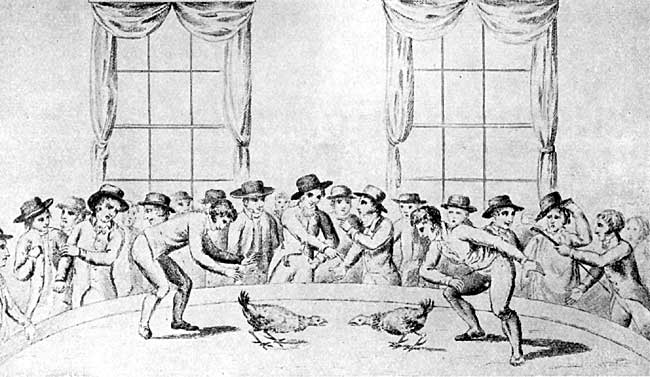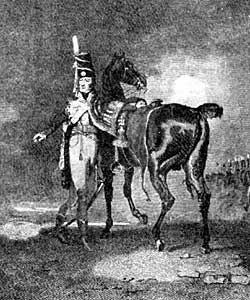< Previous
Cock-Fighting in Nottinghamshire
By Wilfred N. Holden
"His cocks do win the battle still of mine,
When it is all to naught;
and his quails ever
Beat mine, inhoopt, at odds."
Shakespeare (Antony and Cleopatra).

A reproduction of an old Print.
COCK-FIGHTING, or "cocking" as its devotees invariably called it, is one of the most ancient of sports, and can be traced back to Themistocles, Chief Archon of Athens, who lived five hundred years before Christ. In England it flourished with varying success from Henry II's reign until it reached its zenith in the eighteenth and early nineteenth centuries, when it became a national obsession. And although it is now illegal, it is still very far from obsolete, and flourishes in secret places in the Midlands and elsewhere.
In the palmy days of the sport Staffordshire led the way in the country; Wednesbury was the headquarters of the game, and "Wedgebury cocking" became a byword throughout the Midland Counties. Nottingham, however, was always prominent, the chief cock-pits being at the Red Inn, and the White Inn off Long Row. At both hostelries county championships took place between the Gentlemen of Notts, and the Gentlemen of Derbyshire, which were as important at the time as a County Cricket Match at Trent Bridge to-day. About 1825, another pit was started in Maypole Yard. The Sporting Magazine for March 1826, reports that "a new cock-pit has been recently erected in the Maypole Yard, in Nottingham. On the 6th of February a main of cocks was fought there between the Gentlemen of Nottingham (Howe, feeder) and Derbyshire (J. Tomlinson, feeder), when the former beat at the main, and the latter at the bye-fights." Newark was also a great cocking centre, and so remained through several generations, and in 1806 Nottinghamshire beat Yorkshire there. From "Cheny's Historical List," 1729, we learn that "at New-Ark upon Trent in the 3d Week in April, the Earl of Exeter fought the Duke of Rutland, in which Match was shown 41 Cocks a Side for 10 Guineas and 200; The number of Battles in this Match was 34, twenty-three of which were won by the Earl, and 11 by the Duke."
"Feeders" were highly important individuals; they performed all the functions of trainers, and in fact the profession of feeder in cocking corresponded to that of trainer on the Turf. The most famous feeders were the Gillivers of Warwickshire, and Potter, who fed for the twelfth Earl of Derby, but Clay of Notts, was also a prominent man. Feeders did not enter the pit, this duty being undertaken by the "setters-to" or "setters-on," who were governed by an elaborate system of rules.

Colonel Mellish.
Of the many well-known cockers in Nottinghamshire, the most celebrated were Sir Charles Sedley, of Nuthall and Bulwell, and Colonel Mellish of Hodsock Priory. Sir Charles (who, incidentally, was present with the Nottinghamshire Club at the Star and Garter in Pall Mall, when Lord Byron killed Mr. Chaworth) used to fight a main annually in May against Mr. Hugo Meynell, as the representative of Notts, against Derbyshire. This contest took place at the Black-a-Moor's Head, in Ashbourne. W. Sketchley's "The Cocker" (1814) tells us that "when Sir Charles Sedley and Hugo Maynell (sic), Esq. fought their long mains, I believe no contests in the annals of cocking were marked with such general eclat. Their characters as judicious sportsmen stood conspicuously and deservingly high. They fought for large sums, and backed their cocks with such unrivalled spirit, that before or since, no betting has been in equal competition." These two worthies are also referred to in Scott's "British Field Sports," published in 1818, which declares that "the late Sir Charles Sedley and Hugo Meynell, Esq. were the legitimate Successors of Tregonwell Frampton, as the greatest Cockers of their days." William Tregonwell Frampton (1641-1727) had been a very celebrated cocker, who frequented Charles II's pit at Newmarket, and he held the quaint office of "Keeper of the Running Horses" to four monarchs—William III, Anne, George I and George II.
Colonel Mellish, the second cockpit hero of the county, was so much addicted to betting and sport of various kinds, that he nearly ruined himself. He was the son of Mr. Mellish, of Blythe, near Doncaster, and when not engaged at the Nottinghamshire pits he and his friend Sir Francis Boynton frequented the cockpit near Bootham Bar, at York. The Colonel was a crony of the Prince Regent's, and exchanged from the 11th Light Dragoons into the Prince's own regiment, the 10th Hussars. He dissipated most of his fortune through wild speculation on horses and game-cocks, and sold his estate at Blythe to Mr. Walker, a Rotherham iron-founder. Fortunately for Mellish, he was ordered to Spain, and in his absence his relatives set his affairs sufficiently in order to permit of his retaining his smaller seat at Hodsock Priory. In addition to his cocking activities, Colonel Mellish was the backer of Jem Mace, the noted prize-fighter. He died in 1817, and was buried at Blythe.
Cocking was abolished by law in 1849, but lingered on for some years more or less openly, until the game became too risky. One of the last of the old-time cockers, the Hon. Grantley Berkeley, writing in 1865, says:—"It had, however, become so contraband an amusement, that we could only enjoy it under secret and carefully-arranged circumstances. These were always left to me, and then every one of our mains was sure to be attended by a good many members of both Houses of Parliament; also a few of the clergy."
There can be no doubt that this old sport was the cause of much rowdyism, brutality, and fraud, and a case is recorded in which a man put arsenic in some game-cocks' drinking water at Nottingham. This resulted in the formation of the "Association for the Defence of Game Fowls."
< Previous
